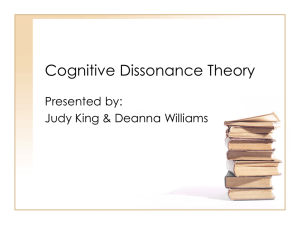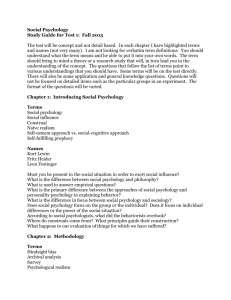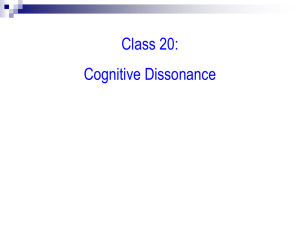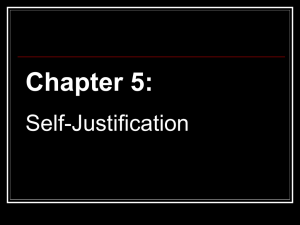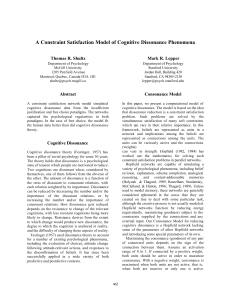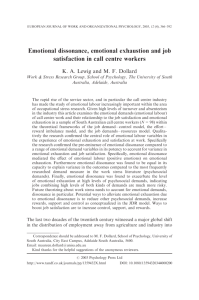Cognitive Dissonance Theory: Festinger Explained
advertisement
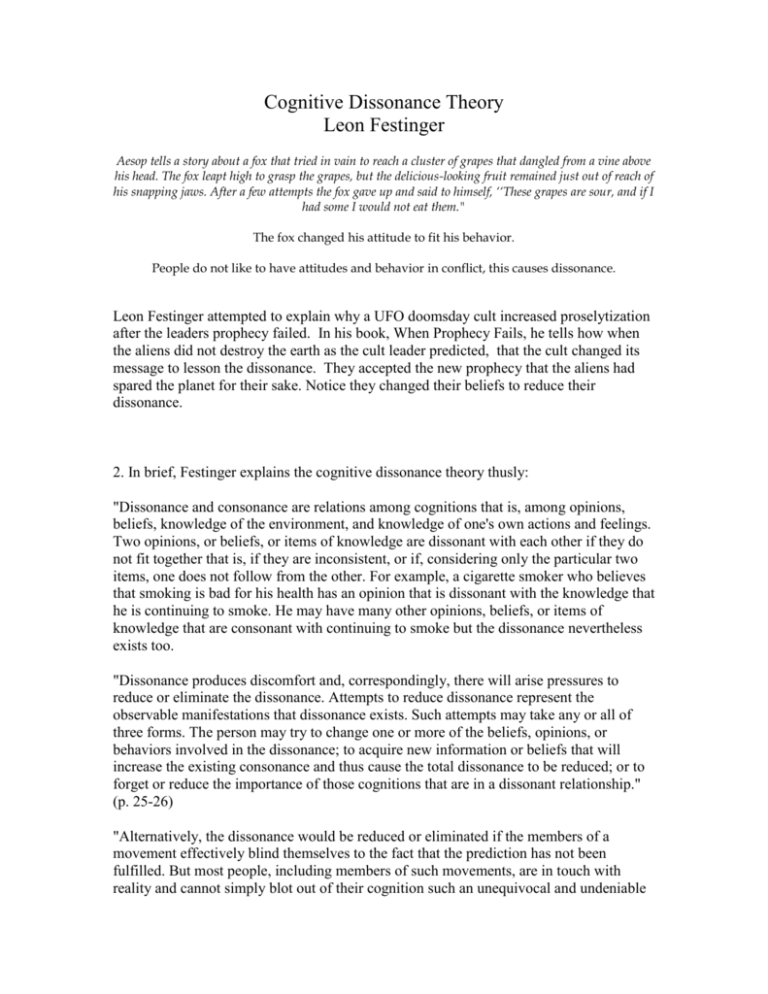
Cognitive Dissonance Theory Leon Festinger Aesop tells a story about a fox that tried in vain to reach a cluster of grapes that dangled from a vine above his head. The fox leapt high to grasp the grapes, but the delicious-looking fruit remained just out of reach of his snapping jaws. After a few attempts the fox gave up and said to himself, ‘‘These grapes are sour, and if I had some I would not eat them." The fox changed his attitude to fit his behavior. People do not like to have attitudes and behavior in conflict, this causes dissonance. Leon Festinger attempted to explain why a UFO doomsday cult increased proselytization after the leaders prophecy failed. In his book, When Prophecy Fails, he tells how when the aliens did not destroy the earth as the cult leader predicted, that the cult changed its message to lesson the dissonance. They accepted the new prophecy that the aliens had spared the planet for their sake. Notice they changed their beliefs to reduce their dissonance. 2. In brief, Festinger explains the cognitive dissonance theory thusly: "Dissonance and consonance are relations among cognitions that is, among opinions, beliefs, knowledge of the environment, and knowledge of one's own actions and feelings. Two opinions, or beliefs, or items of knowledge are dissonant with each other if they do not fit together that is, if they are inconsistent, or if, considering only the particular two items, one does not follow from the other. For example, a cigarette smoker who believes that smoking is bad for his health has an opinion that is dissonant with the knowledge that he is continuing to smoke. He may have many other opinions, beliefs, or items of knowledge that are consonant with continuing to smoke but the dissonance nevertheless exists too. "Dissonance produces discomfort and, correspondingly, there will arise pressures to reduce or eliminate the dissonance. Attempts to reduce dissonance represent the observable manifestations that dissonance exists. Such attempts may take any or all of three forms. The person may try to change one or more of the beliefs, opinions, or behaviors involved in the dissonance; to acquire new information or beliefs that will increase the existing consonance and thus cause the total dissonance to be reduced; or to forget or reduce the importance of those cognitions that are in a dissonant relationship." (p. 25-26) "Alternatively, the dissonance would be reduced or eliminated if the members of a movement effectively blind themselves to the fact that the prediction has not been fulfilled. But most people, including members of such movements, are in touch with reality and cannot simply blot out of their cognition such an unequivocal and undeniable fact. They can try to ignore it, however, and they usually do try. They may convince themselves that the date was wrong but that the prediction will, after all, be shortly confirmed; or they may even set another date as the Millerites did.... Rationalization can reduce dissonance somewhat. For rationalization to be fully effective, support from others is needed to make the explanation or the revision seem correct. Fortunately, the disappointed believer can usually turn to the others in the same movement, who have the same dissonance and the same pressures to reduce it. Support for the new explanation is, hence, forthcoming and the members of the movement can recover somewhat from the shock of the disconfirmation." --Leon Festinger, Henry W. Riecken, and Stanley Schachter, When Prophecy Fails, (New York: Harper and Row, 1956), pp. 27, 28. EXPERIMENTS 1. Students performed tedious and meaningless tasks, consisting of turning pegs quarter-turns and, another one, putting spools onto a tray, emptying the tray, refilling it with spools, and so on. Participants rated these tasks very negatively. After a long period of doing this, students were told the experiment was over and they could leave. The experimenter then asked the subject for a small favor. He was told that a needed research assistant was not able to make it to the experiment, and the participant was asked to fill in and try to persuade another subject (who was actually a confederate) that the dull, boring tasks the subject had just completed were actually interesting and engaging. Some participants were paid $20 for the favor, another group was paid $1, and a control group was not requested to perform the favor. Those paid $1, rated the task more positively than those paid $20. Why? Because when participants were paid only $1, they were forced to internalize the attitude they were induced to express, because they had no other justification. Those in the $20 condition, it is argued, had an obvious external justification for their behavior. Since people don’t want to believe that I am a liar, they convinced themselves that the task was not boring. Therefore, the truth is brought closer to the lie, so to speak, and the rating of the task goes up. One dollar was not justification to lie so they tried to avoid cognitive dissonance. Forbidden toy study In a later experiment Aronson and Carlsmith (1963) viewed cognitive justification to forced compliance in children. The experimenter would question the child on a set of toys to gauge which toys the children liked the most and which they found the least tempting. The experimenter then chose a toy that the child really liked, put them in a room with it, and left the room. Upon leaving the room the experimenter told half the children that there would be a severe punishment if they played with the toy and told the other half that there would be a moderate punishment. Later, when the punishment, whether severe or moderate, was removed, the children in the moderate punishment condition were less likely to play with the toy, even though now it had no repercussion. When questioned, the children in the moderate condition expressed more of a disinterest in the toy than would be expected towards a toy that they had initially ranked high in interest. Alternatively, the desirability of the toy went up for the children in the severe punishment condition. This study laid out the effect of over-justification and insufficient justification on cognition. In over-justification, the personal beliefs and attitudes of the person do not change because they have a good external reason for their actions. The children threatened with the severe punishment had a good external reasoning for not playing with the toy because they knew that they would be badly punished for it. However, they still wanted the toy, so once the punishment was removed they were more likely to play with it. Conversely, the children who would get the moderate punishment displayed insufficient justification because they had to justify to themselves why they did not want to play with the toy since the external motivator, the degree of punishment, was not strong enough by itself. As a result, they convinced themselves that the toy was not worth playing with, which is why even when the punishment was removed they still did not play with the toy. (From the Third Edition of A First Look at Communication Theory by Em Griffin, 1997, McGraw-Hill, Inc. http://www.afirstlook.com/archive/cogdiss.cfm? http://www.fsc.yorku.ca/york/istheory/wiki/images/5/5c/Cdt2.JPG http://thesituationist.files.wordpress.com/2007/09/cognitive-dissonance.jpg


